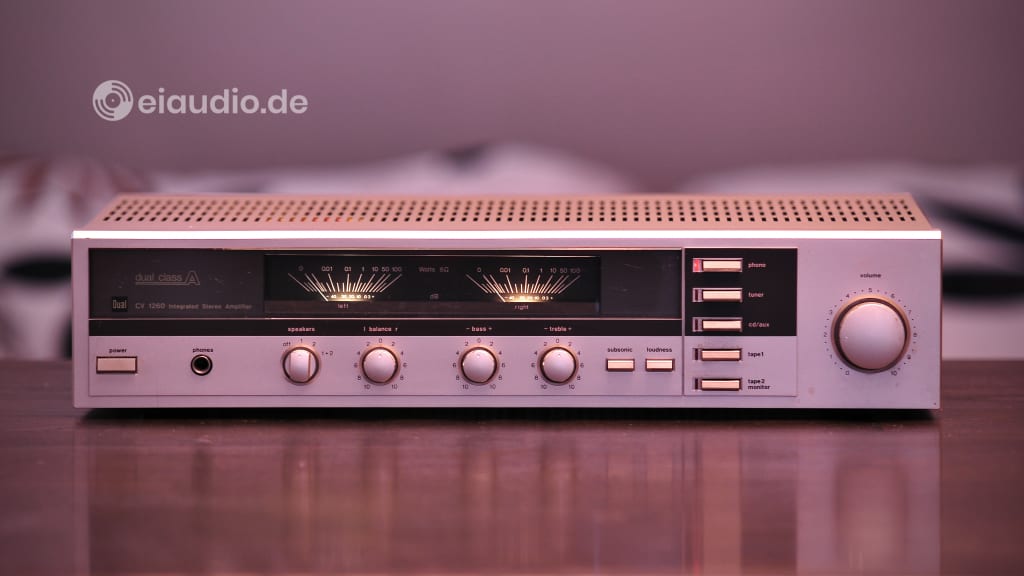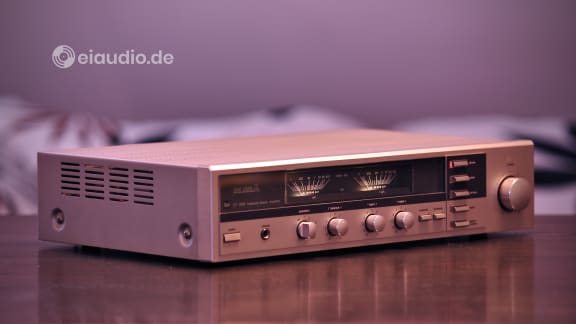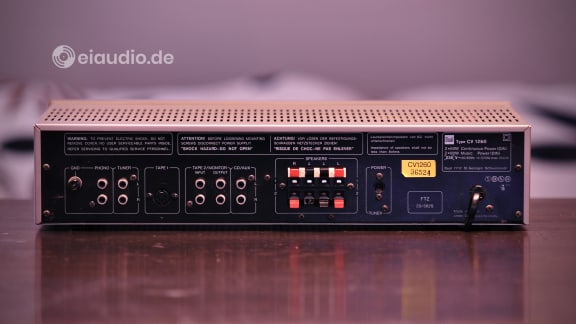Dual CV 1260
Published: 27/03/2023
Manufacturing date: 1983
Author: Karsten Hein
Category: Gear & Review
Tag(s): Integrated Amplifiers
This rather pretty looking Dual CV 1260 integrated amplifier was handed down to my daughter from her recently deceased great aunt. It came along with a Dual CS 630Q direct drive turntable, a Dual CT 1260 tuner that was connected via 5-DIN plug, and a Denon DCD 660 CD player. There was even a Dual C 816 tape deck that I had some trouble finding worthwhile cassettes for in these days. Two Canton GLX 100 bookshelf speakers served to wrap up the Mid-Fi ensemble. Before surrendering these new arrivals at our house to our 9-year-old daughter, I had to test them and make sure the were safe to use, of course. Any publication of these test results is purely incidental, of course.
I must confess that there was something exciting and liberating about reviewing gear at this price level. After all, unless developers were asked to add intentional flaws to their designs, there was no reason why lower-priced gear could not sound as good or even outperform higher priced contenders. Proper acoustics had very little to do with the price of the components and was more reliant on the ingenuity of its designers. The speaker manufacturers Elac and KEF had demonstrated numerous times that audiophile listening pleasures were possible even at modest price points, and examples of purposefully poor designs were not difficult to be found in the industry. Rotel, for instance, had given their RC-9608X preamplifier a plastic floor board that sacrificed the pharadeic cage that the full metal enclosure would otherwise have offered. Manufacturers need to make sure that their devices perform according to the relative position that is reserved for them.
Therefore, I did not know what to expect of Dual’s 1984 amplifier. For one thing, it had a larger brother, the CV 1460 Class-A amplifier of the same year that offered 95 watts per channel into an 8 Ohm load. And then, both devices were no longer built by Dual in Germany, but rather by the Japanese manufacturer Denon. As I unwrapped the 1260 from its protective bubble foil, I noticed how positively sturdy and heavy the unit felt. At just over seven kilos, the moderate-sized amplifier did not feel puny at all. Turning the Dual on for the first time, I was positively surprised by the elegant look of the softly illuminated output level meters. I made a mental note to capture these in my photos of the unit. I did not want to test the CV 1260 in combination with the Canton speakers, and so I hooked up our Epicure 3.0, half expecting the little amp to fail miserably.
I began my listening explorations with Carla Bruni’s 2014 live album A L’Olympia that I played on our trusted Denon DCD 1420 CD player. Our Epicure 3.0 speakers were connected via 2m runs of Belden 9497 as single wire. As both the speakers and the Denon amplifier had spring-loaded binding posts for small diameter speaker bare wire, I had to clip off my usual banana plug terminations. The idea that speaker cables need to be terminated to be of higher quality is relatively modern, of course. In reality, fewer material transitions and less mass in the signal path should have a positive effect on sound. The tinned Belden snapped into place, and, as these cables had already seen many hours of use, the resulting sound was pleasant and balanced from the very first minute. It was the instantly familiar sound signature of excellent receivers, such as the Harman Kardon 730, that surprised me most about the Dual.
In combination with the Epicure 3.0, the midrange sounded warm and alluring. The soundstage was clean and well-ordered, and there was a surprising amount of space around each music event, especially when considering the relatively moderate power of approximately 2x 90 watts into 4 Ohms. Rated at 44 watts power consumption at idle and labelled as Class-A amplifier, it was safe to assume that average household listening volumes were served by pure Class-A transistor power. This certainly showed in the music performance. While the Dual presented a realistic amount of detail, the top-end never felt detached or edgy. There was wonderful cohesion and flow in the music, although the dynamics did not quite reach the level of a Luxman L-10.
Bass performance was in balance with the rest of the music. It was not as tight-fisted as on the Luxman L-10 and also not as boomy as on the Pioneer SX 850. Complex bass sounds were better layered than on the Harman 730. The more I listened, the more I fell in love with the abilities of this integrate amplifier, and as the sun set, I started to enjoy the illuminated front with the level meters waving consistently at under 1 watt. The piano keys on Carla Bruni’s album sounded deliberate and simmered naturally, and I was once again reminded how good the Epicure speakers really were, even when powered by an inconspicuous mid-Fi Dual amplifier from the early 1980s such as this one. What a delightful discovery this was. My daughter would be spoiled from the onset by beginning her journey into music with this Dual.
Specifications
- Type: integrated solid-state amplifier
- Principle: Class-A amplification
- Output power (RMS): 2x 60 watts
- Frequency range: 10 - 45,000 Hz
- Signal-to-noise ratio (line): 88 dB
- Signal-to-noise ratio (phono MM): 68 dB
- Channel separation: input 70 dB / output 55 dB
- Signal damping: >70
- Number of audio inputs: 5
- Phono (cinch): 2.5 mV / 47 kOhm (MM)
- Tuner (cinch): 200 mV / 47 kOhm
- Tape1 (DIN): 200 mV / 47 kOhm
- Tape2 (cinch): 200 mV / 47 kOhm
- Monitor (cinch): 200 mV / 22 kOhm
- Number of audio outputs: 3
- Rec-Out Tape 1 (DIN) / Tape 2 (Cinch, Ri 470 Ohm)
- Headphone socket (jack-type): 6.3 mm
- Tone control: bass and treble (+/- 6 dB), loudness
- Bypass of the tone controls: not available
- Filter: subsonic
- Loudspeaker terminals: two (8-16 Ohm)
- Power consumption: 680 watts (max.), 44 watts idling
- Features: two combined VU meters, illuminated
- Dimensions: (W) 440mm x (H) 97mm x (D) 265mm
- Weight: 7.1 kg
- Country of manufacture: Japan (Denon)
- Year(s): 1983 - 1985





